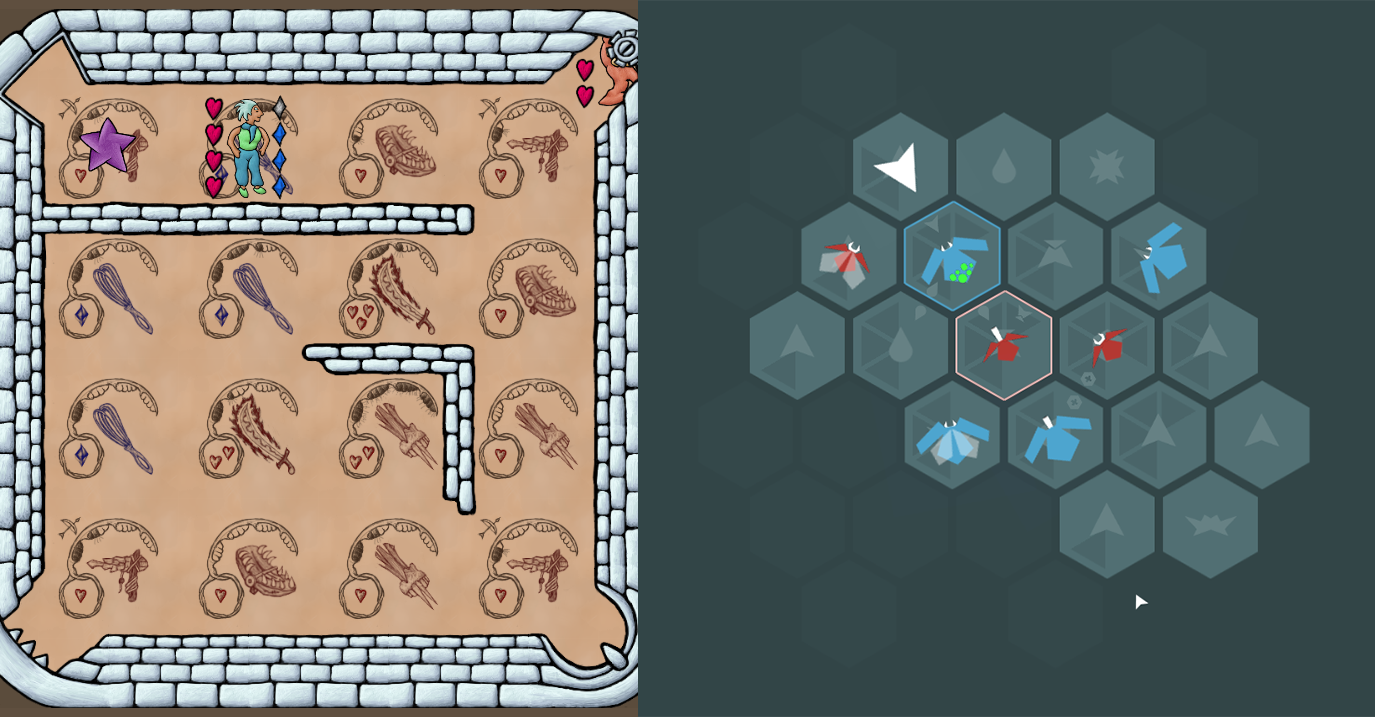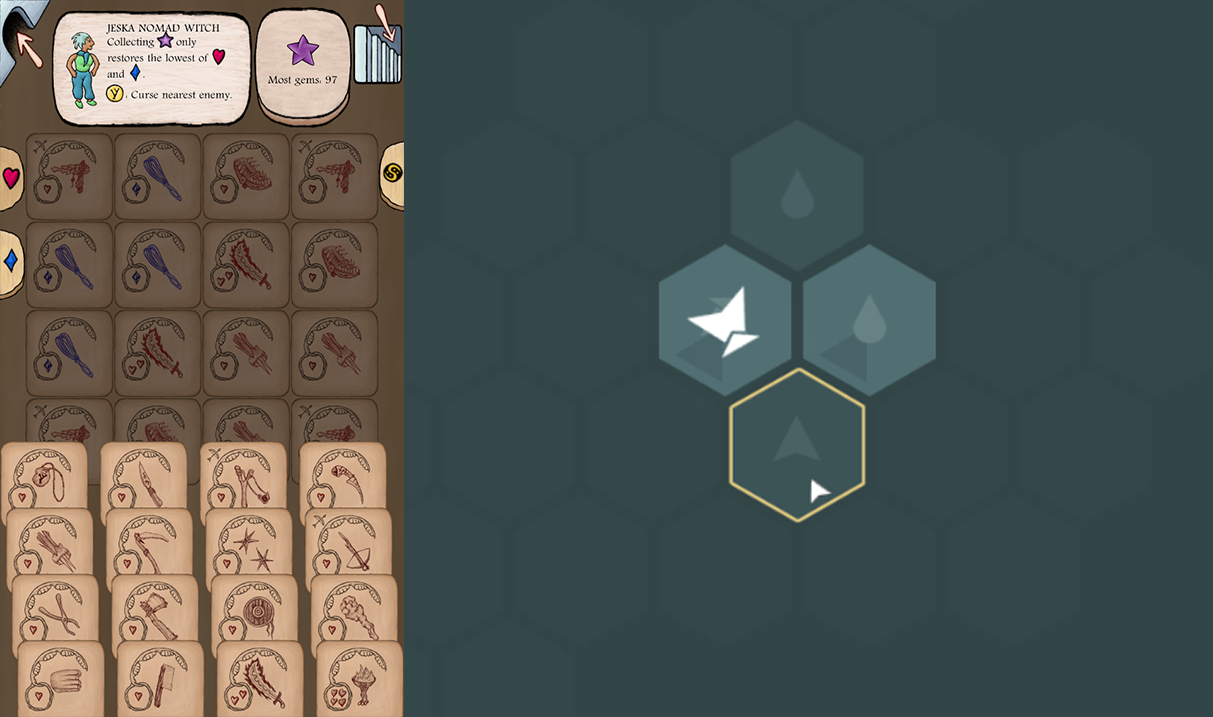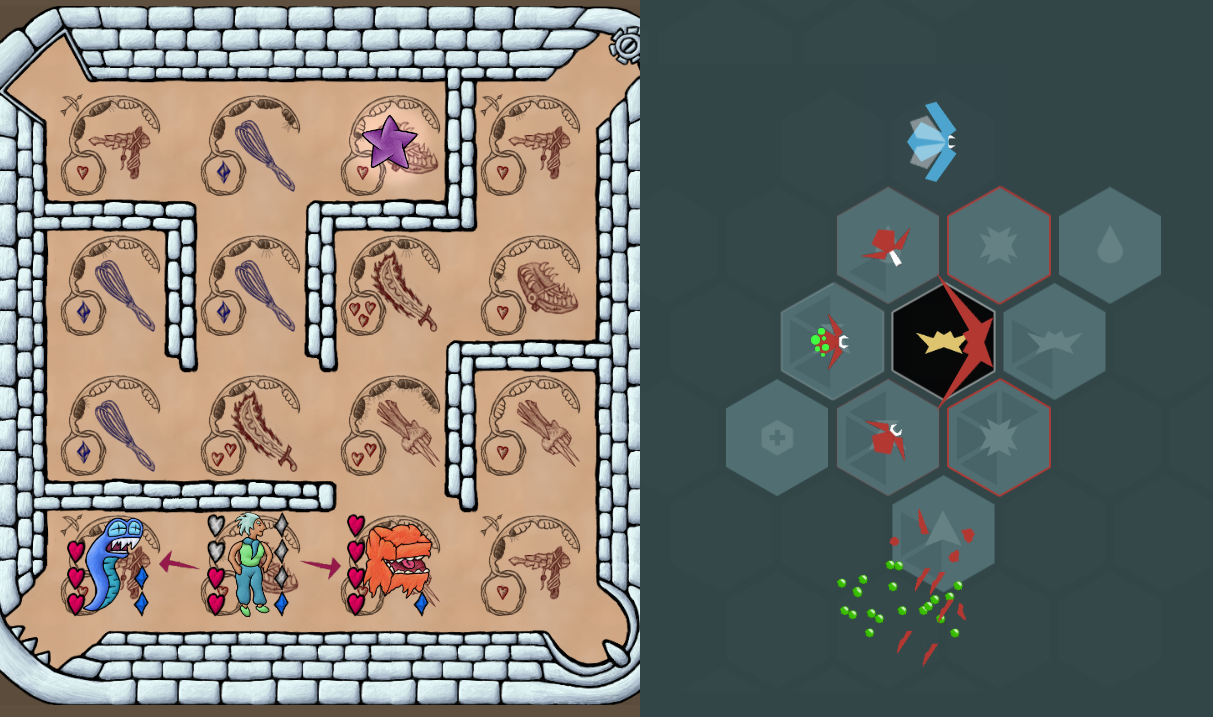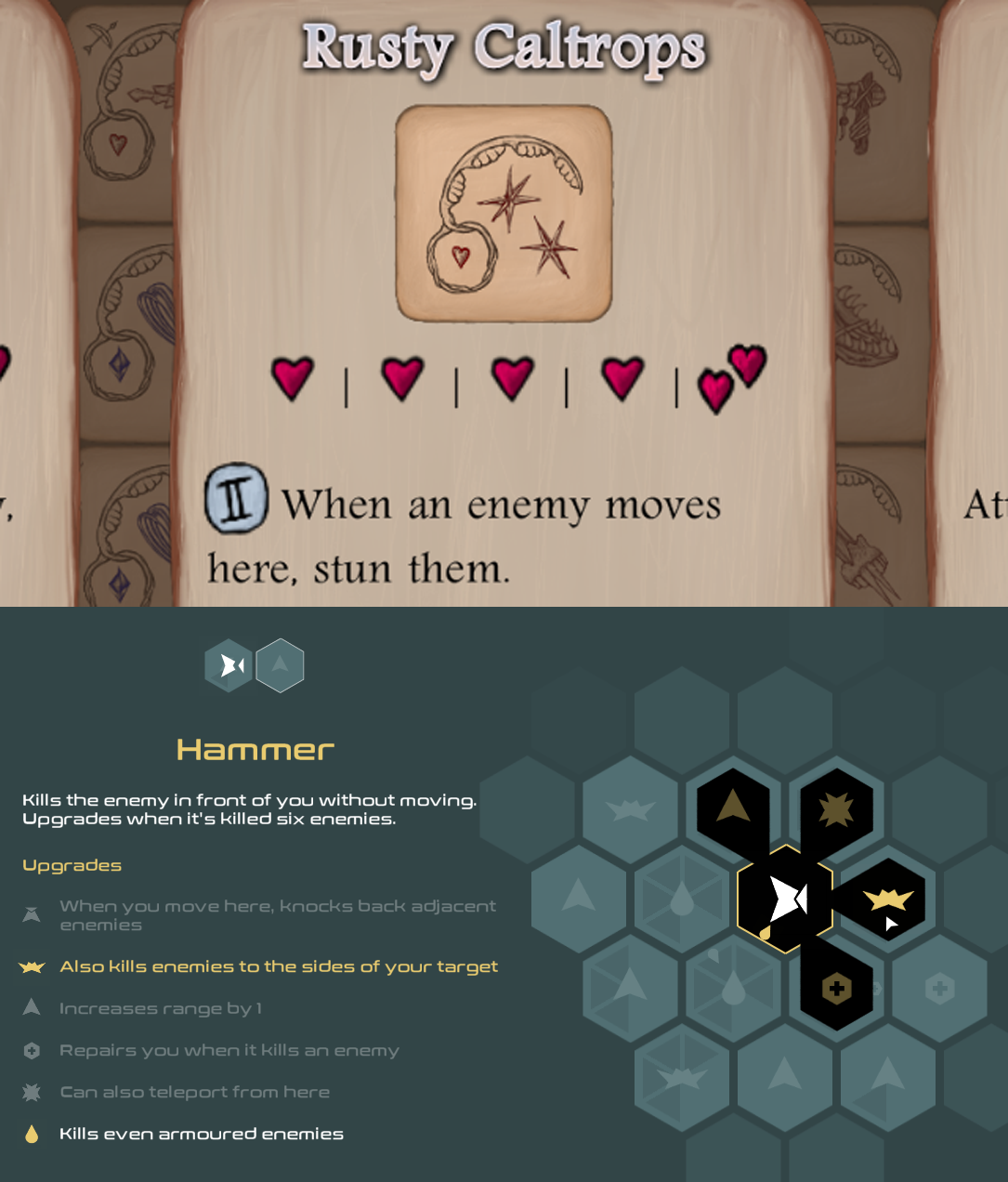TOM FRANCIS
REGRETS THIS ALREADY
Hello! I'm Tom. I'm a game designer, writer, and programmer on Gunpoint, Heat Signature, and Tactical Breach Wizards. Here's some more info on all the games I've worked on, here are the videos I make on YouTube, and here are two short stories I wrote for the Machine of Death collections.
Theme
By me. Uses Adaptive Images by Matt Wilcox.
Search
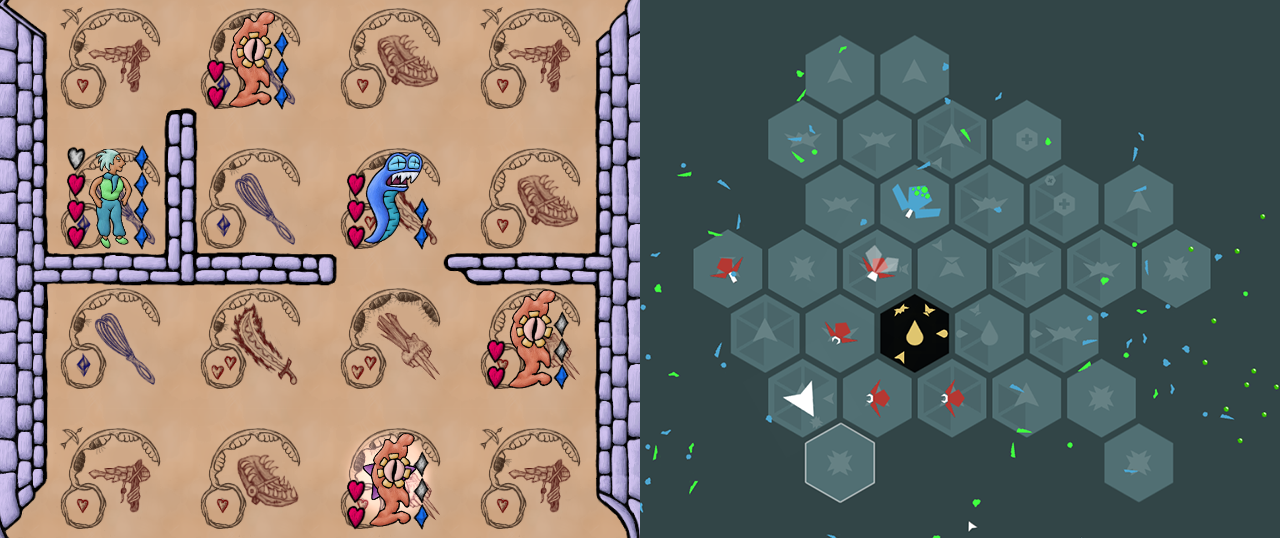
Morphblade And Imbroglio: Making A Game To Test A Critique
I released Morphblade last week, which is a game I made in direct response to Michael Brough’s Imbroglio. They’re both games where you move around a grid of different tile types, and the one you’re standing on determines what you can do there.
I’ve also been playing a lot of XCOM 2 lately, and dreaming up my own indie equivalent to solve its clarity problems. So I started to worry: am I less original now? Have I gravitated towards building on other people’s ideas? Gunpoint was derivative, but at least it was derivative of many things rather than any one game.
But it’s OK, because like so many unoriginal people I found a way to rephrase this to make myself sound good. This is not unoriginal game design, it’s playable games criticism! I used to write about where games went right or wrong, now I actually try fixing their problems and find out if I’m right!
That’s bluster, of course, but it’s reasonably true of Morphblade. It started as a private experiment: I hate getting screwed by the corridor generation in Imbroglio! Couldn’t I just remake Imbroglio and fix that? Can I fix that? Am I right that it would help?
Along the way, I realised I had opinions about almost every other part of Imbroglio, and tried doing each of them my way to see if it worked. Not: “The game has these flaws, I will fix them!” – Imbroglio is hugely successful at being the game it wants to be. More: “I wouldn’t have done it this way, how would my way have worked out?”
So here, specifically, were the main changes I was interested in trying:
Random walls vs no walls
In Imbroglio, you grab a gem to score a point, then the walls of the level regenerate around you and the next gem is in a new spot. Sometimes it generates in such a way that an enemy is now between you and the gem with no alternate routes between you and them. At this point you live or die by what tiles happen to be between you and it – if they all do 1 blue damage and the enemy has 4 blue health, you are dead. On a high level, your death is due to the layout of your board, but in the moment, it always feels like the damn corridors screwing you.
I didn’t end up replacing this with a revised corridor generator, I just scrapped walls altogether. The weapons-as-tiles concept made positioning and movement interesting enough to me – and I ended up doubling down on that with how weapons worked (see Healthbars). I didn’t feel barriers would improve it, especially when they were the cause of my initial problem.
Square grid vs hex grid
I had no problem with Imbroglio’s square grid, but I’d always wanted to try a hex one. I’m also a big fan of Hoplite, and its Slash move taught me that hex grids give you a new way to attack something: moving past it.
Building phase vs build-as-you-go
In Imbroglio, you start by designing a 16 tile grid from a deck of cards, which will be locked in place as soon as you start play. This is at least half the game, and I like it. But it’s a hell of a lot of decision making to frontload – I haven’t relapsed on Imbroglio as much as Hoplite, because when I go back to it I look at that grid and think “Oh jeez.”
Every one of those sixteen decisions is massively important and massively interconnected and there are something like 32 options for each. That’s the game Imbroglio wants to be: it’s not a series of interesting decisions, it’s a cargo container of them, dropped on you from a crane.
I wanted something that was friendlier to dive into, even if it lost that design-a-grid feeling. I was also really resistant to doing two modes – two interfaces, two control schemes, two things to teach. Something about that just clashed with all my instincts towards simplicity, especially for a focused small-scale design experiment.
So you play right away in Morphblade, on a two-tile grid, then after every wave of enemies you add a new hex. Originally you always chose both the type and position of each new hex – if you’ve played it, those occasional blank hexes used to be the only type I gave you. It was essentially a drip-feed of the same type of decisions Imbroglio puts up-front. But I found that led to me building the same grid every time, unless I had some rare insight or theory about a new strategy. I was more interested in a game that used randomisation to nudge you to build a different grid each time you played, where your decision-making is reactive rather than dictatorial.
Figuring out how to do that is where Morphblade changed from something I was gonna release for free in August 2016 to something I felt was worth five bucks in March 2017. The earliest release date Steam could give me in August was the day I left for Stugan, a two month retreat whose organisers had invited me to help me finish Heat Signature. I felt I wouldn’t be honouring that privilege if I spent any of that time on different project, so I watched lots of my new friends play Morphblade but didn’t touch it for two months.
I came back much more bothered by the same-every-time problem, and tried a few solutions. The one that ultimately solved it was simple and obvious, but I rejected it at first because it was incompatible with one of the hex types I had. Eventually I realised I had to step back and re-solve that problem a different way first.
The solution was to give the new hexes I offer you randomly preset types: do you want a Hammer up here, or a Blade down there? You still have a decision to make, but the ones you’re presented with are different each time you play.
That did not work when one of the types was Gun, which could not fire point-blank, because the answer was always “Well not the fucking Gun, obviously.” The Gun only worked as part of cleverly pre-planned designs, which was fundamentally fighting the reactive-design goal I was going for, so I scrapped it and rethunk. The result was Acid, a tile that strips armoured enemies when they move there – a faithful successor to Gun in that is it every bit as unpopular with players, who are every bit as wrong.
Two healthbars vs no healthbars
It looks a bit like everything in Imbroglio has health and mana, but they’re really more like red health and blue health – run out of either of them and you die. The game is deeply about hitpoints, and I am deeply not. I’m not as zealously against them as I used to be, but I generally think if you avoid them you end up with more immediately satisfying interactions.
So every enemy dies in one hit in Morphblade, or they don’t die at all – armoured enemies are immune to conventional attacks. Instead of dealing different amounts of damage, the various tile types in Morphblade just kill in different patterns. Hammer kills the thing in front of you without moving. Blades kill things to the sides as you move. Arrow kills two things in front of you if you have room to move that far.
This changes utility tiles. Imbroglio has a lot of tile types that do something interesting but deal less damage to compensate. I was already a little unhappy with this – if there’s a pendant that increases my mana, it felt weird to have to bludgeon people to death with it again and again until it leveled up enough to do that. It felt like all these tile types were reluctantly working two jobs: they didn’t really want to be damage dealers, but that’s how things level up so they would half-heartedly let you use them that way.
So Morphblade’s other three tile types do no damage at all. Repair, Teleport and Acid don’t let you directly hurt enemies, though in Morphblade you can always move into an enemy to shove them back. The shoving thing prevents them from being a total liability – a zero damage tile in Imbroglio, which can exist, is a deathtrap – but the other problem is how do they level up? I went for the next most obvious way: when things die on them.
It was actually Morphblade that convinced me hitpoints have their virtues – for the player. It matters a lot less if an enemy hitting you is satisfying – it probably won’t be – and having just two or three HP gives a lot more breathing room for strategies and mistakes. In particular, being in Scenario X has starkly different implications and options if you have 2 health vs if you have 1, so the interesting possibility space is expanded. The more health you allow the fuzzier and less interesting those differences get, so I kept it simple: you can take one hit without dying. With the right upgrades, you can take two.
32+ tile types vs 6 tile types
Imbroglio has lots and lots of cards, almost all with unique effects. But with Morphblade, I was really interested in trying something that didn’t take fucking ages to make.
Straight upgrades vs cross-breeds
Each tile in Imbroglio has its own upgrade path, usually increasing in damage a little and eventually unlocking some special effect. If I was going to have fewer tile types, maybe I could give you more options in how you upgrade them? Branching upgrade trees might be good, but I’m always looking for ways to collapse things down and reuse or mix together existing elements. If Suspicious Developments had one of those aspirational corporate mottos, it would be “combining things in sometimes interesting ways perhaps”. So I thought about letting you cross-breed one hex type with another.
I could have let you add the effects of any hex type onto any other, but with six types and six sides to a hexagon, I couldn’t resist making it about adjacency. So if you want to upgrade a Hammer to kill things to the sides like Blades, you’ve got to build a Blades hex next to it before you level it up. This adds a bunch of extra considerations onto which types of hex you want in which positions, which makes the multiple-choice building system more interesting. You design your possible upgrade paths by how you construct your board, then you kill things to earn the upgrades, then you choose between the options you’ve given yourself.
I had a few rules for these combinations:
Asymmetry: upgrading type A with type B should make a different hex to upgrading B with A.
Stackability: upgrading A with B should not stop you also upgrading A with C.
Nonredundancy: upgrading A with B can be more useful than upgrading A with C, but it should not render upgrading A with C pointless.
Desirability: upgrading A with B shouldn’t stop you doing something significantly useful you could do with A alone.
Exaggeration: upgrading A with A should make A better at A’s job.
This meant coding 36 different upgrades, at least 18 of which had to be redone as hex types were replaced or redesigned. This took fucking ages to make.
Conclusion
I haven’t talked about whether I think each of these changes worked, because in isolation, of course I do. If I didn’t, I would have reverted them or done something else. But that doesn’t mean I think the game is better overall. In fact, I think they’ve steered it far enough from Imbroglio that they don’t feel like two attempts to do the same thing. When the press wrote about Morphblade’s launch, Imbroglio wasn’t even the most common point of comparison – it was Hoplite.
The big one is scrapping the build phase. That moves it to a different genre. I think it ended up feeling like Space Hulk to Imbroglio’s Warhammer 40K: much smaller possibility space, but less set up, and aiming to scratch a different itch.
I’m very happy with Morphblade’s simplicity / depth balance. It’s less deep than Imbroglio, but deeper than other games with so few elements. It got a lot better when I added the list of all possible upgrades on the description of each tile: you’re constantly being presented with a menu of all the complexity the game has to offer, but you don’t have to worry about most if it because you only have a few options at each stage.
I also like that the strategies players have found successful are not at all the same as mine. The highest scores I’ve seen are based on super upgraded time-stopping teleporters, a strategy I’ve never got to work. And I’ve seen lots of others beat my high score with other builds, ones I haven’t tried. I use Arrows, obsessively, and sometimes worried that Arrows are just too good, so obviously better than other hexes. But I’ve seen no hint of that preference from other players, so it seems like it supports a bunch of different styles.
So Morphblade probably ended up being more successful as an exercise in game making than in game critique, but I’m happy anywhere on that spectrum.
Reading Michael’s posts about Imbroglio’s design makes me all the more appreciative of how much work and thought of his I’m benefiting from when I draw inspiration from the final product. I’m glad I got to hug and thank him properly at GDC this year.
More Morphblade
